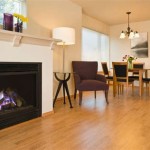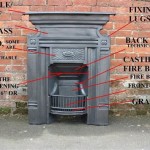In-Wall Wood Burning Fireplaces: Design, Installation, and Considerations
In-wall wood-burning fireplaces represent a sophisticated architectural element, seamlessly integrating the warmth and ambiance of a traditional hearth into the structure of a home. Unlike freestanding models, these fireplaces are designed to be recessed directly into a wall, creating a flush or near-flush aesthetic. This integration optimizes space utilization, enhances visual appeal, and provides a focal point for interior design. The implementation of an in-wall wood-burning fireplace necessitates careful planning and adherence to building codes due to the inherent requirements for fire safety and ventilation.
The process of selecting and installing an in-wall wood-burning fireplace involves several crucial steps. These steps encompass evaluating structural integrity, choosing an appropriate fireplace model, managing venting requirements, and ensuring proper installation by qualified professionals. Neglecting any of these aspects can compromise the fireplace's functionality, safety, and longevity. Consequently, a comprehensive understanding of the features, benefits, and challenges associated with in-wall wood-burning fireplaces is essential for homeowners considering this type of heating and aesthetic enhancement.
Assessing Structural Integrity and Code Compliance
The successful integration of an in-wall wood-burning fireplace begins with a thorough assessment of the building's structure. The designated wall must be capable of supporting the fireplace's weight, which can be considerable depending on its size and construction materials. A structural engineer may be required to evaluate the load-bearing capacity and recommend any necessary reinforcement. This is particularly relevant for older homes or those with non-standard wall constructions. Modification to walls may involve incorporating additional framing to distribute the load and prevent structural compromise.
In addition to structural considerations, strict adherence to local building codes and regulations is paramount. These codes dictate specific requirements for fireplace installation, including clearances to combustible materials, chimney height and placement, and fire safety measures. Fire codes are designed to minimize the risk of fire hazards and carbon monoxide poisoning. Failure to comply with these regulations can result in fines, mandated modifications, or even the fireplace being deemed unusable. It is essential to consult with local building officials or a qualified fireplace installer to ensure full compliance before commencing any installation work.
Moreover, consideration must be given to the wall's existing infrastructure. Electrical wiring, plumbing, and HVAC systems may need to be relocated to accommodate the fireplace and its venting system. This can add to the overall cost and complexity of the project, necessitating careful planning and coordination with relevant tradespeople. A detailed assessment of the wall's internal structure will help identify potential obstacles and allow for proactive solutions. This careful examination of the wall structure will save time and money during the fireplace installation process.
Selecting the Appropriate Fireplace Model and Venting System
The market offers a diverse range of in-wall wood-burning fireplace models, each with unique features, designs, and heating capacities. Factors to consider when selecting a model include the size of the room to be heated, the desired aesthetic, and the budget. Fireplaces are typically rated in terms of British Thermal Units (BTUs), which indicates their heating output. Choosing a fireplace with an appropriate BTU rating ensures efficient heating without excessive fuel consumption.
The design of the fireplace should complement the overall style of the home. Options range from traditional designs with ornate detailing to modern designs with clean lines and minimalist aesthetics. The materials used in the fireplace's construction also play a significant role in its appearance and durability. Cast iron, steel, and firebrick are common materials known for their heat resistance and longevity. The fireplace door or screen should also be chosen with aesthetics and safety in mind. Glass doors can enhance the view of the fire while providing an additional layer of protection against sparks and embers.
Proper venting is critical for the safe and efficient operation of a wood-burning fireplace. The venting system is responsible for removing smoke and combustion gases from the fireplace and expelling them outside. There are two main types of venting systems for in-wall fireplaces: masonry chimneys and prefabricated metal chimneys. Masonry chimneys are constructed from brick or stone and offer a traditional aesthetic. Prefabricated metal chimneys are lighter and easier to install, making them a popular choice for many homes. The chimney must be sized correctly for the fireplace to ensure adequate draft and prevent smoke from entering the home. The height of the chimney must also comply with building codes to prevent downdraft from nearby obstructions.
Installation Procedures and Safety Considerations
The installation of an in-wall wood-burning fireplace is a complex task that should be performed by qualified professionals with experience in fireplace installation and construction. Improper installation can lead to serious safety hazards, including fire, carbon monoxide poisoning, and structural damage. The installation process typically involves preparing the wall opening, connecting the venting system, installing the fireplace unit, and finishing the surrounding area.
Preparing the wall opening involves framing the area to create a secure and fire-resistant enclosure for the fireplace. Non-combustible materials, such as cement board or fire-rated gypsum board, should be used to line the enclosure and protect the surrounding wall structure. The venting system must be carefully connected to the fireplace and extended through the wall and roof. All joints and connections must be properly sealed to prevent leaks and ensure a tight seal. The fireplace unit is then installed within the prepared enclosure and secured in place. The surrounding area is typically finished with decorative materials, such as stone, brick, or tile, to create the desired aesthetic.
Ensuring safety during and after the installation is of utmost importance. A carbon monoxide detector should be installed near the fireplace to provide an early warning in case of a leak. The fireplace should be regularly inspected and maintained to ensure that all components are in good working order. The chimney should be cleaned annually to remove creosote buildup, which can pose a fire hazard. Homeowners should also be educated on proper fireplace operation, including the use of appropriate fuel, the importance of maintaining a clear chimney draft, and the safe disposal of ashes. Proper ventilation of the room must be maintained while the fireplace is in use. These safety steps will ensure that the fireplace remains a safe and enjoyable feature within the home.
Furthermore, consider the environmental impact of wood-burning fireplaces. While the warmth and ambiance are appealing, combustion releases particulate matter and other pollutants into the atmosphere. Adhering to local regulations regarding wood burning, using seasoned wood, and ensuring efficient combustion within the system minimizes the fireplace's environmental footprint. Newer models often incorporate technology designed to reduce emissions and improve efficiency, representing a more environmentally conscious choice.
The integration of an in-wall wood-burning fireplace involves a significant investment of both time and resources. Considering the complexities of structural modifications, code compliance, model selection, and installation, homeowners must prioritize meticulous planning and professional guidance. The resulting aesthetic enhancement and supplemental heating, however, can contribute substantially to a home's value and ambiance.

Wood Burning Fireplaces Dubuque Ia

Garden Projects 2024 Wood Stove Hearth Rustic House Home Fireplace

Jotul C24 Inset 7kw Wood Burning Cassette Fire Bonfire Fireplaces

Fondis Stella 3 Double Sided 13 5 Kw Inset Stove

Vogue Midi T Wood Burning Stove

Wall Mounted Wood Burning Stove Smart And Modern See Selection Here Hwam

Vidar Triple Large Wall The Fireplace Super

Dik Geurts Bora Wall Wood Burning Stove Coeval Fires

Pin On Wood Stove Wall

Wood Inserts Fireplace Xtrordinair Made In America








